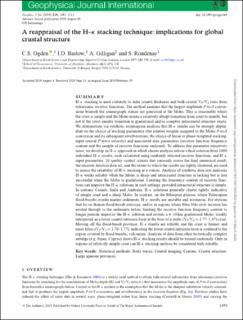| dc.description.abstract | H–κ stacking is used routinely to infer crustal thickness and bulk-crustal VP/VS ratio from teleseismic receiver functions. The method assumes that the largest amplitude P-to-S conversions beneath the seismograph station are generated at the Moho. This is reasonable where the crust is simple and the Moho marks a relatively abrupt transition from crust to mantle, but not if the crust–mantle transition is gradational and/or complex intracrustal structure exists. We demonstrate via synthetic seismogram analysis that H–κ results can be strongly dependent on the choice of stacking parameters (the relative weights assigned to the Moho P-to-S conversion and its subsequent reverberations, the choice of linear or phase-weighted stacking, input crustal P-wave velocity) and associated data parameters (receiver function frequency content and the sample of receiver functions analysed). To address this parameter sensitivity issue, we develop an H–κ approach in which cluster analysis selects a final solution from 1000 individual H–κ results, each calculated using randomly selected receiver functions, and H–κ input parameters. 10 quality control criteria that variously assess the final numerical result, the receiver function data set, and the extent to which the results are tightly clustered, are used to assess the reliability of H–κ stacking at a station. Analysis of synthetic data sets indicates H–κ works reliably when the Moho is sharp and intracrustal structure is lacking but is less successful when the Moho is gradational. Limiting the frequency content of receiver functions can improve the H–κ solutions in such settings, provided intracrustal structure is simple. In cratonic Canada, India and Australia, H–κ solutions generally cluster tightly, indicative of simple crust and a sharp Moho. In contrast, on the Ethiopian plateau, where Palaeogene flood-basalts overlie marine sediments, H–κ results are unstable and erroneous. For stations that lie on thinner flood-basalt outcrops, and/or in regions where Blue Nile river incision has eroded through to the sediments below, limiting the receiver function frequency content to longer periods improves the H–κ solution and reveals a 6–10 km gradational Moho, readily interpreted as a lower crustal intrusion layer at the base of a mafic (VP/VS = 1.77–1.87) crust. Moving off the flood-basalt province, H–κ results are reliable and the crust is thinner and more felsic (VP/VS = 1.70–1.77), indicating the lower crustal intrusion layer is confined to the region covered by flood-basaltic volcanism. Analysis of data from other tectonically complex settings (e.g. Japan, Cyprus) shows H–κ stacking results should be treated cautiously. Only in regions of relatively simple crust can H–κ stacking analysis be considered truly reliable. | en_US |
